
LOADING ...
In response to evolving domestic opinion, eMedals Inc has made the conscious decision to remove the presentation of German Third Reich historical artifacts from our online catalogue. For three decades, eMedals Inc has made an effort to preserve history in all its forms. As historians and researchers, we have managed sensitive articles and materials with the greatest of care and respect for their past and present social context. We acknowledge the growing sentiments put forth by the Canadian public and have taken proactive actions to address this opinion.
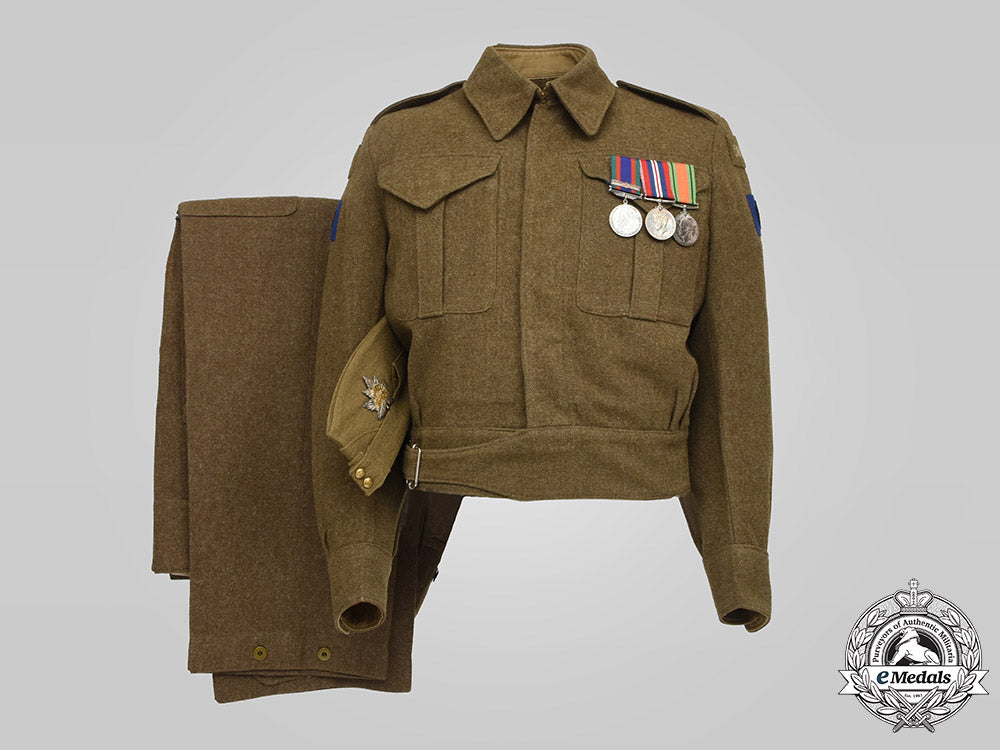
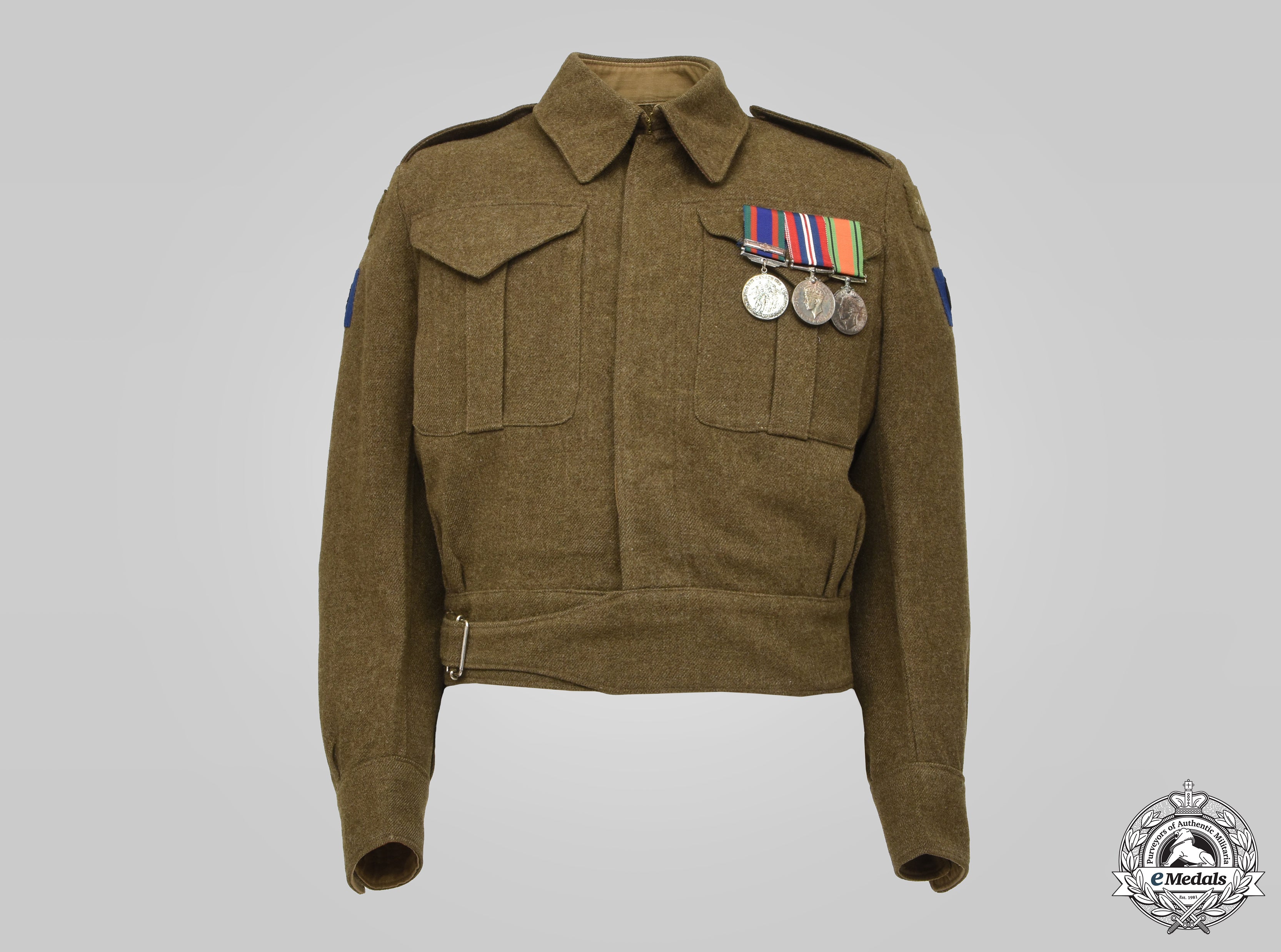

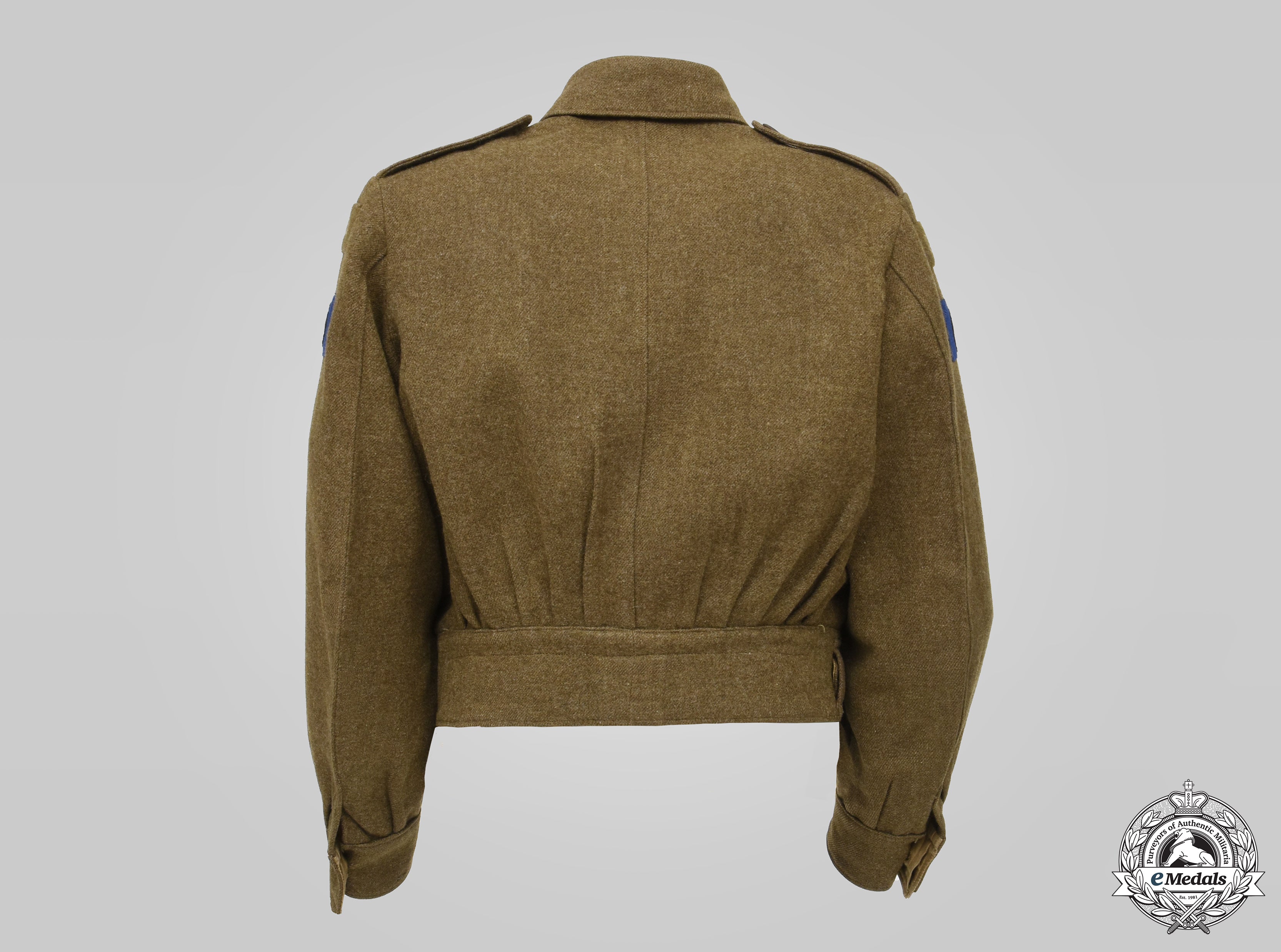
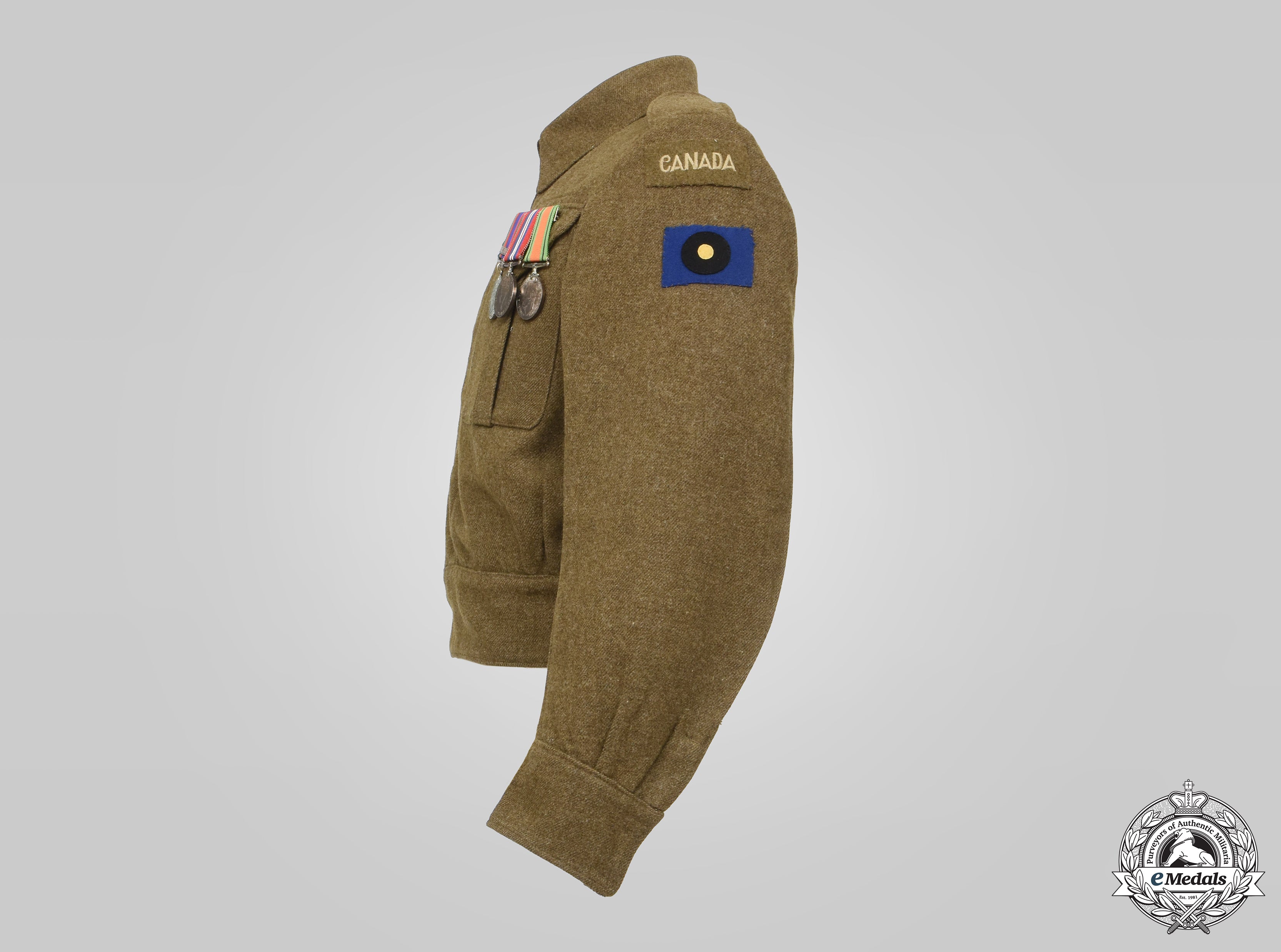
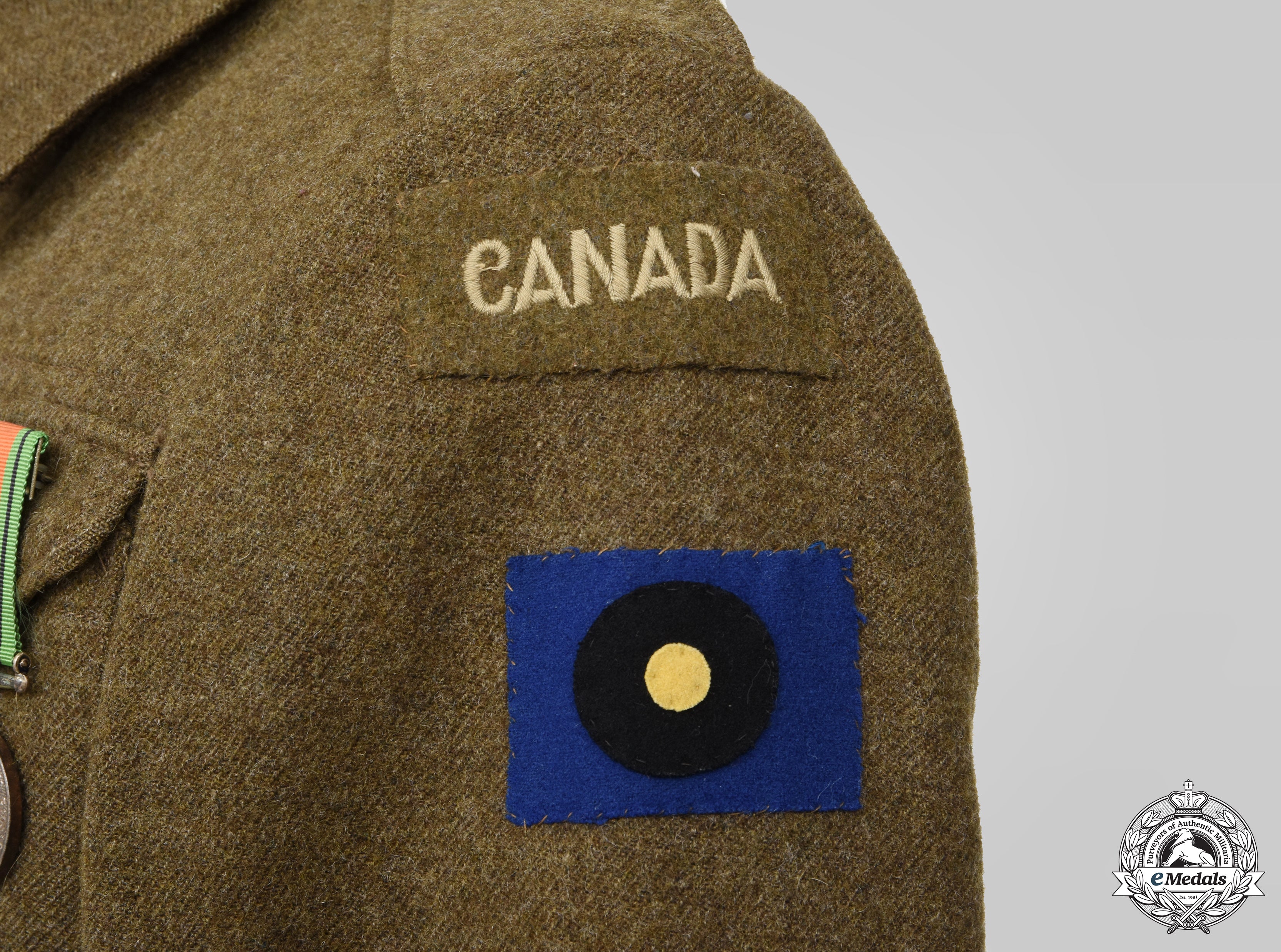


Canada, Commonwealth. A Battle Dress Uniform & Side Cap, Viii Recce, Essex Scottish Regiment
Canada, Commonwealth. A Battle Dress Uniform & Side Cap, Viii Recce, Essex Scottish Regiment
SKU: ITEM: C6527
0% Buyer's Premium
Current Bid:
Your Max Bid:
Bid History:
Time Remaining:
Couldn't load pickup availability
Shipping Details
Shipping Details
eMedals offers rapid domestic and international shipping. Orders received prior to 12:00pm (EST) will be shipped on the same business day.* Orders placed on Canadian Federal holidays will be dispatched the subsequent business day. Courier tracking numbers are provided for all shipments. All items purchased from eMedals can be returned for a full monetary refund or merchandise credit, providing the criteria presented in our Terms & Conditions are met. *Please note that the addition of a COA may impact dispatch time.
Shipping Details
eMedals offers rapid domestic and international shipping. Orders received prior to 12:00pm (EST) will be shipped on the same business day.* Orders placed on Canadian Federal holidays will be dispatched the subsequent business day. Courier tracking numbers are provided for all shipments. All items purchased from eMedals can be returned for a full monetary refund or merchandise credit, providing the criteria presented in our Terms & Conditions are met. *Please note that the addition of a COA may impact dispatch time.
Description
Description
Includes six pieces: Battledress Blouse (exterior in wool with a green tinge to the darker khaki colour, giving it that distinctive Canadian-look versus the British version, of which the Canadian one is patterned after, adorned with CANADA shoulder flashes, along with 72 mm (w) x 47 mm (h) rectangular patches representative of the 8th Reconnaissance Regiment (VIII RECCE) in yellow, black and blue wool sewn in place on the upper sleeves on both sides, button down epaulette straps, the right strap held in place via a large brown plastic button, the left strap missing its button, with the threading for it remaining, the original button can still be found in the right breast pocket. There is a dual hook and eye on the collar ensuring a snug fit at the neckline, the front with two pockets, one on each breast which have decorative straps giving them a pleated-look with brownish-green finished metal buttons at the top, each pocket with a fold over flap and when lifted up, exposes a reinforced buttonhole, when the buttons are fastened, they remain invisible to the eye, covered by the flaps. There is a Canadian Volunteer Service Medal with Overseas Clasp, War Medal 1939-1945 and Defence Medal mounted to a suspension bar that is pinned in place via a swing bar pinback to the flap on the left pocket. The front has a vertical row of five brownish-green finished metal buttons on the right side, facing an equal number of reinforced button holes on the left side, similarly covered by a full-length flap, again remaining invisible to the eye, the waistline at the front with a strap on the left side, and when fed through the metal belt loop on the right side, ensures a snug fit at the waist. Both sleeves have button down cuffs with brownish-green finished metal buttons on both sides, with three reinforced ventilation holes in each armpit. Inside, the waistline is reinforced with a 72 mm wide cotton band, with three reinforced buttonholes at the rear, the inside lapel on both sides have deep cotton-lined pockets with side entries, the left side pocket stamped in black ink with the Canadian Broad Arrow production insignia, the right side pocket with a white cotton manufacturer's label inscribed in black ink "BATTLE DRESS / BLOUSES, SERGE / Size No. 5 / Tip Top Tailors, Limited" and number stamped "2068" in blue ink, the bottom edge stitching of the label having come away. The blouse measures 420 mm across the shoulders and 500 mm in length overall); Trousers (exterior in wool with a green tinge to the darker khaki colour, giving it that distinctive Canadian-look versus the British version, matching that used on the battledress blouse. They come with a button down fly, with five brownish-green finished metal buttons on the right side, facing an equal number of reinforced button holes on the left side, under a flap, and when fastened, remain invisible to the eye. There is a series of four large belt loops spaced at intervals around the waist and held in place via the same metal buttons as used on the fly, with three additional buttons at the waist at the rear in between the belt loops. It has three cotton-lined pockets, two on each side at the front with a traditional hip-side entry and one of the right rear seat with a metal button and fold over flap. In addition, there is a smaller button down pocket overlaying the right hip pocket, with a brownish-green finished metal button. Inside at the waist there are six more brownish-green finished metal buttons, plus two markings on the waistband: his service number "A22238" inscribed in black ink at the left rear and the Canadian Broad Arrow production insignia in black ink on the right side. The leg cuffs each have a two buttons on the outer side and one button with a tab on the inseam side, each of the buttons in brownish-green finished metal. The trousers measure 720 mm around at the waist x 1,050 mm in length overall); Side Cap (with a finely textured greenish brown cotton/wool blend exterior, with fold down panels held up via two hook and eye closures on either side, the end straps secured at the front via two small brass Canada General Service insignia buttons, a 50.8 mm (w) x 49 mm (h) silvered and gilt 8th Reconnaissance Regiment (VIII RECCE) cap badge affixed in place via lugs and pin on the left side, the interior lined in black cotton, with a 48 mm wide moss green cotton sweatband, stamped in white ink with the Canadian Broad Arrow production insignia in the dome and maker marked "NATIONAL HAT MFG. CO.", dated "1940" and size marked "7 1/2" within a circular border at the right front, the cap measuring 310 mm (w) x 115 mm (h)); Essex Scottish Regiment Shoulder Title (which was banned from being worn while overseas: in brass, measuring 48 mm (w) x 19.5 mm (h), both lugs and pin intact); General Service Badge (in sterling silver with red and blue enamels, numbered "015267" on the reverse, button hole attachment with blue wool swatch backer, measuring 14.5 mm (w) x 21.8 mm (h)); and Canadian Volunteer Service Medal Ribbon Bar (silver maple left on its original ribbon, measuring 31.5 mm (w) x 10.5 mm (h)). The wool used in the blouse and trousers display nice texture and quality workmanship, retaining their original look through quality stitching and the high grade materials used. Extremely fine.
Accompanied by copies of his Attestation Paper, Service Records, Medical Records and Discharge Certificate, along with a Department of State of the United States Application for Citizenship Resumption, State of Michigan Department of Heath Certificate of Death, and research papers initiated by his son, Michael Robert Smith.
Footnote: Wilbert "William" Emmett Smith was born on April 8, 1910 in Hankinson, Richland County, North Dakota, the son of Robert E. Smith and Mary Jane Smith (nee Delaney). He is acknowledged as having had measles and mumps as a child, pneumonia at the age of 7 and a haemorrhoidectomy (an operation to remove severe haemorrhoids, also known as piles) in 1937. Smith was an American citizen and was a resident of Dickenson, North Dakota, when he enlisted as a Trooper (A-22238) with the Essex Scottish Regiment, signing his Canadian Active Service Force Attestation Paper on May 22, 1940 in Windsor, Ontario, at the age of 30, naming his next-of-kin as his mother, Mary Jane Smith, stating that he had no previous military service, that he was Single, that his religion was Roman Catholic and his trade as that of Fireman (Steam). Although his Christian name was Wilbert, he is acknowledged as William while in the Canadian Army. By joining the Canadian Army, he would lose his American citizenship in the process. He went overseas a month later, on June 22, 1940, where the Essex Scottish Regiment was attached to the 2nd Canadian Infantry Division, 8th Reconnaissance Regiment (VIII RECCE). While stationed in England, Trooper Smith was in an accident while riding a motorcycle, on December 27, 1940. He was taken to Cambridge Hospital, where a diagnosis of a Pott's fracture in his left ankle was made (a Pott’s fracture is a type of ankle fracture that is characterized by a break in one or more bony prominences on the sides of the ankle known as the malleoli. During certain activities such as landing from a jump, or when rolling an ankle, stress is placed on the tibia and fibula. When this stress is traumatic, and beyond what the bone can withstand, a break in the medial, lateral or posterior malleolus may occur. When this happens this condition is known as a Pott’s fracture. Because of the large forces required to break the tibia or fibula, a Pott’s fracture often occurs in combination with other injuries such as a sprained ankle or other fractures of the foot, ankle or lower leg). Five months after the accident, with casts having subsequently been applied while in hospital, he was discharged to his unit with a walking caliper (brace) on May 21, 1941. He was admitted to No. 15 Canadian General Hospital, where he had a bone graft on his left ankle medial malleolus for non-union. Five weeks after his admission to hospital, Trooper Smith was discharged to No. 1 Canadian Convalescent Depot on June 26, 1941 and would return to his Reinforcement Unit fourteen weeks later, on October 1st. He would have a month of physiotherapy "with no improvement" and was re-boarded on November 29, 1941, declared Category "C2", the attending physician noting that he "has been unable to carry on even in this lowered category". He was part of the Canadian Legion Educational Services while incapacitated. Trooper Smith was re-examined at No. 15 Canadian General Hospital on January 26, 1942, where the physician noted that "movement at the ankle may be slightly less than it formerly was". He attended a re-examination on February 27, 1942 at No. 15 Canadian General Hospital, where it was noted that the injury was "becoming more painful". The attending physician made the following observation: "Clinically this man shows some improvement, radiologically and symptomatically there is none. He has never been a very stoical individual and it seems unlikely that he will improve in this respect. In view of the radiological findings and his continued ineffectiveness, he should be re-categorized". In his Medical History of an Invalid, dated March 10, 1942 at Blackdown, Hampshire, in regards to his left ankle Pott's fracture and the resultant arthritis, the physician noted that Smith had "Pain and stiffness in (his) left leg. Hurts considerably when he walks." He went on to state that "There is a 4" scar on (the) medial aspect of (his) left ankle over (the) medial malleolus due to (the) operation. The ankle joint is widened and (the) muscles of (the) leg atrophied about 1 inch. There is some restriction of movement of (the) ankle joint and pain is elicited on movement. Walks with a limp and has some flat of (the) left foot, all movements somewhat restricted". The Medical Board was of the opinion that his "disability is progressive" and that he would "not be able to carry on effectively in any category". The Board recommended that he be placed in Category "E" (Unfit for service in Categories A, B and C = General Service, Service Abroad, Home Service) and that he be discharged accordingly. He returned to Canada in May 1942 and would miss the Dieppe Raid on August 19, 1942, that his unit, the Essex Scottish Regiment, along with the Royal Hamilton Light Infantry, would be participants in the main frontal assault. Of the nearly overall 5,000-strong Canadian contingent, 3,367 were killed, wounded or taken prisoner, an exceptional casualty rate of 68%. A-22238 Trooper Wilbert "William" Emmett Smith was discharged for "being unable to meet the required military physical standards", at Wolseley Barracks, No. 4 District Depot in London, Ontario, on June 11, 1942, credited with having served in Canada and England, entitled to wear the General Service Badge, number "015267". For his Second World War service, he was awarded the Defence Medal, the Canadian Volunteer Service Medal with Overseas Clasp and the War Medal 1939-1945. Since he was an American citizen who joined a foreign army, he technically lost his American citizenship by doing so. After the war, his American citizenship was re-instated when he took the Oath of Renunciation and Allegiance at the United States Consulate in Sarnia, Ontario, on October 9, 1947. It was here that he filled out his "application to resume citizenship in the United States by a person who, while a citizen of the United States, lost his citizenship in order to perform military service during the Second World War in the army of a country at war with a country with which the United States is or was at war and the form of oath required to be taken to resume citizenship". He later was employed as an Automobile Salesman and married Mary (nee Hogg) Smith, the couple having a son, Michael Robert Smith. Wilbert "William" Emmett Smith died from an acute myocardial infraction (heart attack), brought on by coronary atherosclerosis (a buildup of plaque inside the artery walls, the buildup causing the inside of the arteries to become narrower and slows down the flow of blood, a condition that had been diagnosed in him three years earlier), on August 26, 1962 in Marysville, St. Clair County, Michigan, at the age of 52. His wife, Mary, died on May 4, 2004.
Description
Includes six pieces: Battledress Blouse (exterior in wool with a green tinge to the darker khaki colour, giving it that distinctive Canadian-look versus the British version, of which the Canadian one is patterned after, adorned with CANADA shoulder flashes, along with 72 mm (w) x 47 mm (h) rectangular patches representative of the 8th Reconnaissance Regiment (VIII RECCE) in yellow, black and blue wool sewn in place on the upper sleeves on both sides, button down epaulette straps, the right strap held in place via a large brown plastic button, the left strap missing its button, with the threading for it remaining, the original button can still be found in the right breast pocket. There is a dual hook and eye on the collar ensuring a snug fit at the neckline, the front with two pockets, one on each breast which have decorative straps giving them a pleated-look with brownish-green finished metal buttons at the top, each pocket with a fold over flap and when lifted up, exposes a reinforced buttonhole, when the buttons are fastened, they remain invisible to the eye, covered by the flaps. There is a Canadian Volunteer Service Medal with Overseas Clasp, War Medal 1939-1945 and Defence Medal mounted to a suspension bar that is pinned in place via a swing bar pinback to the flap on the left pocket. The front has a vertical row of five brownish-green finished metal buttons on the right side, facing an equal number of reinforced button holes on the left side, similarly covered by a full-length flap, again remaining invisible to the eye, the waistline at the front with a strap on the left side, and when fed through the metal belt loop on the right side, ensures a snug fit at the waist. Both sleeves have button down cuffs with brownish-green finished metal buttons on both sides, with three reinforced ventilation holes in each armpit. Inside, the waistline is reinforced with a 72 mm wide cotton band, with three reinforced buttonholes at the rear, the inside lapel on both sides have deep cotton-lined pockets with side entries, the left side pocket stamped in black ink with the Canadian Broad Arrow production insignia, the right side pocket with a white cotton manufacturer's label inscribed in black ink "BATTLE DRESS / BLOUSES, SERGE / Size No. 5 / Tip Top Tailors, Limited" and number stamped "2068" in blue ink, the bottom edge stitching of the label having come away. The blouse measures 420 mm across the shoulders and 500 mm in length overall); Trousers (exterior in wool with a green tinge to the darker khaki colour, giving it that distinctive Canadian-look versus the British version, matching that used on the battledress blouse. They come with a button down fly, with five brownish-green finished metal buttons on the right side, facing an equal number of reinforced button holes on the left side, under a flap, and when fastened, remain invisible to the eye. There is a series of four large belt loops spaced at intervals around the waist and held in place via the same metal buttons as used on the fly, with three additional buttons at the waist at the rear in between the belt loops. It has three cotton-lined pockets, two on each side at the front with a traditional hip-side entry and one of the right rear seat with a metal button and fold over flap. In addition, there is a smaller button down pocket overlaying the right hip pocket, with a brownish-green finished metal button. Inside at the waist there are six more brownish-green finished metal buttons, plus two markings on the waistband: his service number "A22238" inscribed in black ink at the left rear and the Canadian Broad Arrow production insignia in black ink on the right side. The leg cuffs each have a two buttons on the outer side and one button with a tab on the inseam side, each of the buttons in brownish-green finished metal. The trousers measure 720 mm around at the waist x 1,050 mm in length overall); Side Cap (with a finely textured greenish brown cotton/wool blend exterior, with fold down panels held up via two hook and eye closures on either side, the end straps secured at the front via two small brass Canada General Service insignia buttons, a 50.8 mm (w) x 49 mm (h) silvered and gilt 8th Reconnaissance Regiment (VIII RECCE) cap badge affixed in place via lugs and pin on the left side, the interior lined in black cotton, with a 48 mm wide moss green cotton sweatband, stamped in white ink with the Canadian Broad Arrow production insignia in the dome and maker marked "NATIONAL HAT MFG. CO.", dated "1940" and size marked "7 1/2" within a circular border at the right front, the cap measuring 310 mm (w) x 115 mm (h)); Essex Scottish Regiment Shoulder Title (which was banned from being worn while overseas: in brass, measuring 48 mm (w) x 19.5 mm (h), both lugs and pin intact); General Service Badge (in sterling silver with red and blue enamels, numbered "015267" on the reverse, button hole attachment with blue wool swatch backer, measuring 14.5 mm (w) x 21.8 mm (h)); and Canadian Volunteer Service Medal Ribbon Bar (silver maple left on its original ribbon, measuring 31.5 mm (w) x 10.5 mm (h)). The wool used in the blouse and trousers display nice texture and quality workmanship, retaining their original look through quality stitching and the high grade materials used. Extremely fine.
Accompanied by copies of his Attestation Paper, Service Records, Medical Records and Discharge Certificate, along with a Department of State of the United States Application for Citizenship Resumption, State of Michigan Department of Heath Certificate of Death, and research papers initiated by his son, Michael Robert Smith.
Footnote: Wilbert "William" Emmett Smith was born on April 8, 1910 in Hankinson, Richland County, North Dakota, the son of Robert E. Smith and Mary Jane Smith (nee Delaney). He is acknowledged as having had measles and mumps as a child, pneumonia at the age of 7 and a haemorrhoidectomy (an operation to remove severe haemorrhoids, also known as piles) in 1937. Smith was an American citizen and was a resident of Dickenson, North Dakota, when he enlisted as a Trooper (A-22238) with the Essex Scottish Regiment, signing his Canadian Active Service Force Attestation Paper on May 22, 1940 in Windsor, Ontario, at the age of 30, naming his next-of-kin as his mother, Mary Jane Smith, stating that he had no previous military service, that he was Single, that his religion was Roman Catholic and his trade as that of Fireman (Steam). Although his Christian name was Wilbert, he is acknowledged as William while in the Canadian Army. By joining the Canadian Army, he would lose his American citizenship in the process. He went overseas a month later, on June 22, 1940, where the Essex Scottish Regiment was attached to the 2nd Canadian Infantry Division, 8th Reconnaissance Regiment (VIII RECCE). While stationed in England, Trooper Smith was in an accident while riding a motorcycle, on December 27, 1940. He was taken to Cambridge Hospital, where a diagnosis of a Pott's fracture in his left ankle was made (a Pott’s fracture is a type of ankle fracture that is characterized by a break in one or more bony prominences on the sides of the ankle known as the malleoli. During certain activities such as landing from a jump, or when rolling an ankle, stress is placed on the tibia and fibula. When this stress is traumatic, and beyond what the bone can withstand, a break in the medial, lateral or posterior malleolus may occur. When this happens this condition is known as a Pott’s fracture. Because of the large forces required to break the tibia or fibula, a Pott’s fracture often occurs in combination with other injuries such as a sprained ankle or other fractures of the foot, ankle or lower leg). Five months after the accident, with casts having subsequently been applied while in hospital, he was discharged to his unit with a walking caliper (brace) on May 21, 1941. He was admitted to No. 15 Canadian General Hospital, where he had a bone graft on his left ankle medial malleolus for non-union. Five weeks after his admission to hospital, Trooper Smith was discharged to No. 1 Canadian Convalescent Depot on June 26, 1941 and would return to his Reinforcement Unit fourteen weeks later, on October 1st. He would have a month of physiotherapy "with no improvement" and was re-boarded on November 29, 1941, declared Category "C2", the attending physician noting that he "has been unable to carry on even in this lowered category". He was part of the Canadian Legion Educational Services while incapacitated. Trooper Smith was re-examined at No. 15 Canadian General Hospital on January 26, 1942, where the physician noted that "movement at the ankle may be slightly less than it formerly was". He attended a re-examination on February 27, 1942 at No. 15 Canadian General Hospital, where it was noted that the injury was "becoming more painful". The attending physician made the following observation: "Clinically this man shows some improvement, radiologically and symptomatically there is none. He has never been a very stoical individual and it seems unlikely that he will improve in this respect. In view of the radiological findings and his continued ineffectiveness, he should be re-categorized". In his Medical History of an Invalid, dated March 10, 1942 at Blackdown, Hampshire, in regards to his left ankle Pott's fracture and the resultant arthritis, the physician noted that Smith had "Pain and stiffness in (his) left leg. Hurts considerably when he walks." He went on to state that "There is a 4" scar on (the) medial aspect of (his) left ankle over (the) medial malleolus due to (the) operation. The ankle joint is widened and (the) muscles of (the) leg atrophied about 1 inch. There is some restriction of movement of (the) ankle joint and pain is elicited on movement. Walks with a limp and has some flat of (the) left foot, all movements somewhat restricted". The Medical Board was of the opinion that his "disability is progressive" and that he would "not be able to carry on effectively in any category". The Board recommended that he be placed in Category "E" (Unfit for service in Categories A, B and C = General Service, Service Abroad, Home Service) and that he be discharged accordingly. He returned to Canada in May 1942 and would miss the Dieppe Raid on August 19, 1942, that his unit, the Essex Scottish Regiment, along with the Royal Hamilton Light Infantry, would be participants in the main frontal assault. Of the nearly overall 5,000-strong Canadian contingent, 3,367 were killed, wounded or taken prisoner, an exceptional casualty rate of 68%. A-22238 Trooper Wilbert "William" Emmett Smith was discharged for "being unable to meet the required military physical standards", at Wolseley Barracks, No. 4 District Depot in London, Ontario, on June 11, 1942, credited with having served in Canada and England, entitled to wear the General Service Badge, number "015267". For his Second World War service, he was awarded the Defence Medal, the Canadian Volunteer Service Medal with Overseas Clasp and the War Medal 1939-1945. Since he was an American citizen who joined a foreign army, he technically lost his American citizenship by doing so. After the war, his American citizenship was re-instated when he took the Oath of Renunciation and Allegiance at the United States Consulate in Sarnia, Ontario, on October 9, 1947. It was here that he filled out his "application to resume citizenship in the United States by a person who, while a citizen of the United States, lost his citizenship in order to perform military service during the Second World War in the army of a country at war with a country with which the United States is or was at war and the form of oath required to be taken to resume citizenship". He later was employed as an Automobile Salesman and married Mary (nee Hogg) Smith, the couple having a son, Michael Robert Smith. Wilbert "William" Emmett Smith died from an acute myocardial infraction (heart attack), brought on by coronary atherosclerosis (a buildup of plaque inside the artery walls, the buildup causing the inside of the arteries to become narrower and slows down the flow of blood, a condition that had been diagnosed in him three years earlier), on August 26, 1962 in Marysville, St. Clair County, Michigan, at the age of 52. His wife, Mary, died on May 4, 2004.








You May Also Like
Japan, Empire. A T90 Civil Defense Helmet, c.1943
W8287
Canada, Commonwealth; United Kingdom. A Mixed Lot of St. John Ambulance Association Medals and Uniform Insignia
M0231-134
Canada, Commonwealth. A Pair of St. John Ambulance Medals to Charles E. Jefkins, Hamilton, Ontario Superintendent
M0231-128
Canada, Commonwealth. A Lot of Awards, Documents, and Photographs to Peter Mori, St. John Ambulance Corps Superintendent for Hamilton, Ontario
M0231-122
Canada, CEF. A Large Oval Photo
C7175
-
Japan, Empire. A T90 Civil Defense Helmet, c.1943
W8287
Add to CartRegular price $275 USDRegular price $0 USD Sale price $275 USDUnit price / per -
Canada, Commonwealth; United Kingdom. A Mixed Lot of St. John Ambulance Association Medals and Uniform Insignia
M0231-134
Add to CartRegular price $135 USDRegular price $0 USD Sale price $135 USDUnit price / per -
Canada, Commonwealth. A Pair of St. John Ambulance Medals to Charles E. Jefkins, Hamilton, Ontario Superintendent
M0231-128
Add to CartRegular price $100 USDRegular price $0 USD Sale price $100 USDUnit price / per -
Canada, Commonwealth. A Lot of Awards, Documents, and Photographs to Peter Mori, St. John Ambulance Corps Superintendent for Hamilton, Ontario
M0231-122
Add to CartRegular price $225 USDRegular price $0 USD Sale price $225 USDUnit price / per -
Canada, CEF. A Large Oval Photo
C7175
Add to CartRegular price $120 USDRegular price $0 USD Sale price $120 USDUnit price / per
Do you have a similar item you are interested in selling?
Please complete the form and our client care representatives will contact you.
Sell Item




















